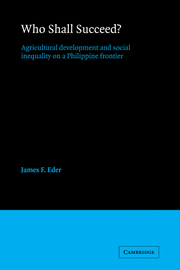Book contents
- Frontmatter
- Contents
- List of tables, figures, and maps
- Preface
- 1 Introduction
- 2 Rich man, poor man: life in a frontier farming community
- 3 The economic and social origins of the migrant farmers
- 4 Eight migrants
- 5 The origins of social inequality
- 6 The maintenance of social inequality: earning a living
- 7 The maintenance of social inequality: earning prestige
- 8 The perpetuation of social inequality?
- 9 Conclusion
- Appendixes
- Notes
- Bibliography
- Index
2 - Rich man, poor man: life in a frontier farming community
Published online by Cambridge University Press: 23 May 2010
- Frontmatter
- Contents
- List of tables, figures, and maps
- Preface
- 1 Introduction
- 2 Rich man, poor man: life in a frontier farming community
- 3 The economic and social origins of the migrant farmers
- 4 Eight migrants
- 5 The origins of social inequality
- 6 The maintenance of social inequality: earning a living
- 7 The maintenance of social inequality: earning prestige
- 8 The perpetuation of social inequality?
- 9 Conclusion
- Appendixes
- Notes
- Bibliography
- Index
Summary
San Jose lies 8 kilometers away from Puerto Princesa, the economic and political center of Palawan Province (see Map 2.1). Rectangular in shape and covering 758 hectares of unirrigated flatland, it has a population of 112 households, with a total of 763 people. The national road running north from Puerto Princesa transects the community and at 1-kilometer intervals sends feeder roads off in opposite directions. On the east side, these roads end in the mangrove swamps that buffer San Jose from its only natural boundary, the ocean. On its remaining three sides San Jose borders neighboring communities. Along the highway travel buses bound for distant northern communities and the numerous jitneys and tricycles (motorcycles equipped with sidecars) that handle local traffic to and from town.
Seen from the air, San Jose is unimpressive. The landscape is a patchwork of scrubby regrowth and coconut, banana, and fruit tree orchards. Only the community school and church stand out as prominent structures. Barely visible are three stores and two rice mills, the only other nonresidential buildings in the village. Scattered here and there are tin-roofed houses and well-kept vegetable gardens, the only indications from afar that San Jose is progressive, developing, and, by rural Philippine standards, a relatively well-to-do community.
Nor does such an aerial view provide much indication of the recentness of San Jose's development. What is today San Jose was a virtually unbroken expanse of virgin forest during the early 1930s.
- Type
- Chapter
- Information
- Who Shall Succeed?Agricultural Development and Social Inequality on a Philippine Frontier, pp. 8 - 29Publisher: Cambridge University PressPrint publication year: 1982

